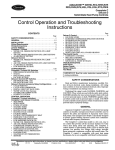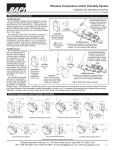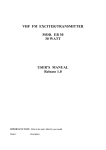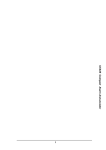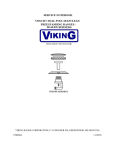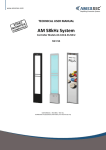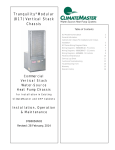Download Carrier WEATHER MASTER P3 Specifications
Transcript
CXM CONTROLS CXM Digital Heat Pump Controller Application, Operation & Maintenance 97B0003N12 Rev.: 03 January, 2011 CXM Electronic Controls Features Comparison 3 CXM Electronic Heat Pump Control 4 CXM Physical Dimensions & Layout 5 CXM Controls 6 CXM Service & Application Notes 10 Troubleshooting Information 12 Troubleshooting Chart 13 CXM Wiring Diagram 14 Functional Troubleshooting 15 Performance Troubleshooting 17 Revision History 20 WATER-SOURCE HEAT PUMPS CXM Unit Control R e v. : 0 3 J a n u a r y, 2 0 1 1 This Page Intentionally Left Blank 2 THE SMART SOLUTION FOR ENERGY EFFICIENCY CXM Unit Control R e v. : 0 3 J a n u a r y, 2 0 1 1 CXM Electronic Controls Features Comparison Basic Features CXM CXM-Lon High and Low Refrigerant Pressure Protection S S S Water Coil Low Temperature Cutout S S S True 24VA Thermostat Signals S S S Thermostat Inputs Compatible with Triacs S S S† † † CXM-MPC Condensate Overflow Sensor S S S Anti-Short-Cyle Time Delay S S S Random Start S S S Alarm (selectable dry contact or 24VA) S S S Water Valve Relay Water Valve Relay with Compressor Delay S S S N/A N/A N/A Emergency Shutdown N/A DDC DDC Night Setback with Override N/A DDC DDC Outdoor Air Damper Control N/A N/A N/A Advanced Features Intelligent Reset S S S High and Low Voltage Protection S S S Air Coil Low Temperature Cutout S S S Low Temperature Setpoint Field Select (water, antifreeze) S S S Electric Heat Control Outputs S S S Boilerless Electric Heat Control N/A N/A N/A Intelligent Reversing Valve Operation N/A DDC DDC High/Low Fan Speed Outputs N/A N/A N/A Intelligent Fan Speed Control N/A N/A N/A N/A Thermostat Type Select (Y,O or Y,W) N/A N/A Reversing Valve Signal Select (O or B) N/A N/A N/A Dehumidistat Input N/A N/A N/A Reheat Dehumidification Control* N/A N/A N/A Multiple Units on One Thermostat/Wall Sensor N/A DDC DDC Service and Reliability Features Service Test Mode S S S LED Fault and Status Lights S S S Fault Memory after Reset S S S Unit Performance Sentinel S S S Harness-Type Factory Wiring Connections S S S Fully Noise-Tested Design S S S CE Approval S S S N/A N/A N/A N/A S N/A BACNET Compliant N/A N/A S Johnson N2 Compliant N/A N/A S Removable Low Voltage Connector DDC / Energy Management Features Echelon LonMark Compliant Modbus Compliant N/A N/A S Leaving Air and Water Temperature Sensor N/A S S Digital Wall Sensor N/A O O S = Standard O = Optional DDC = Feature can be provided by DDC System CXM-Lon = CXM with LonMark Module CXM-MPC = CXM with MPC Module * = Check with your Factory Representative for model availability MPC = Multiple ProtoCol (BACNET, N2, Modbus) † = Compatible with our thermostats. For customer supplied thermostat, check with Controls Engineering Department for approval. 3 WATER-SOURCE HEAT PUMPS CXM Unit Control R e v. : 0 3 J a n u a r y, 2 0 1 1 CXM Electronic Heat Pump Control CXM Overview The CXM electronic control is a microprocessor based heat pump controller that is simple to use, yet provides all the necessary features to improve the operation and safety of water source heat pumps. Grounding The control board is grounded through two of the metal standoffs. Field connection ratings for the CXM control: ‘A’ terminal: 20VA at 24VAC. CXM Controller Part Number: 17B0001N01 CXM Control Board Product Specification Features • Anti-short cycle protection • High and low pressure cutouts • Water coil low temperature cut-out • Air coil low temperature cut-out • Random start • Unit Performance Sentinel • Over/under voltage protection • Diagnostic LED • Reset lockout at unit or disconnect • Intelligent reset • Condensate overflow sensor • Test Mode • Electric heat outputs • Accessory water valve connection General Operating Parameters The following are general operating parameters for the CXM control: • Operating Environment: -40°F to 176°F and up to 95% relative humidity, non-condensing. • Storage Environment: -40°F to 185°F and up to 95% relative humidity, non-condensing. Power Requirements: • CXM only power draw • Normally 5 VA draw at 24VAC. • Maximum 9 VA draw at 24VAC. • A dedicated 24VAC, 50-60Hz, 1Ph, 40VA transformer minimum is required for typical WSHP application. Relay Contact Ratings The following relays are mounted on the CXM control: • Compressor Relay: 40VA at 24VAC. • Alarm Relay: 28VA at 24VAC. 4 THE SMART SOLUTION FOR ENERGY EFFICIENCY CXM Unit Control R e v. : 0 3 J a n u a r y, 2 0 1 1 CXM Physical Dimensions & Layout Factory 0.250” Quick Connects 4.00” BR C R BRG Test CCG CC Off On Comp Relay 5 Dip SW JW3 JW2 1 FP1 Low Temp FP2 Low Temp Y 6.00” Field Thermostat Connections Y W O G R C AL1 AL2 A Micro 12 Status LED JW1- AL2 Dry P2 HP HP LP LP FP1 FP1 FP2 FP2 RV RV CO CO P3 1 24Vdc EH1 4 EH2 P1 Alarm Relay Factory Low Voltage Molex connector for unit harness 5.50” Factory Low Voltage Molex connector for electric heat harness 3/8” standoff CO 3.50” Use 4 Mounting Screws: #6 sheet metal screw 1” long 1.50” Rev: 6/7/10 5 WATER-SOURCE HEAT PUMPS CXM Unit Control R e v. : 0 3 J a n u a r y, 2 0 1 1 CXM Controls Field Selectable Inputs Test Mode - Test Mode allows the service personnel to check the operation of the control in a timely manner. By momentarily shorting the test terminals, the CXM control enters a 20 minute Test Mode period in which all time delays are sped up 15 times. Upon entering Test Mode, the Status LED will flash a code representing the last fault. For diagnostic ease at the thermostat, the Alarm Relay will also cycle during Test Mode. The Alarm Relay will cycle on and off similar to the status LED to indicate a code representing the last fault, at the thermostat. Note: Code 1 indicates there is no fault in memory; stated differently, the control has not faulted since the last power-down to power-up sequence. Test Mode can be exited by shorting the test terminals for 3 seconds.Test Mode can also be entered and exited by cycling the G input, 3 times within a 60 second time period. During Test Mode, the control monitors to see if the FP1 and FP2 thermistors are in the appropriate place. If the control is in Test Mode, the control will lockout with Code 9 after 30 seconds if: the compressor is On in Cooling Mode and the FP1 sensor is colder than the FP2 sensor, or, the compressor is On in Heating Mode and the FP2 sensor is colder than the FP1 sensor. Table 1: LED & Alarm Relay Operations Description of Operation LED Alarm Normal Mode ON Normal Mode w/UPS Warning ON CXM is non-functional Fault Retry Lockout OFF Slow Flash Fast Flash Over/Under Voltage Shutdown Slow Flash Test Mode - No Fault in Memory Test Mode - HP Fault in Memory Test Mode - LP Fault in Memory Test Mode - FP1 Fault in Memory Test Mode - FP2 Fault in Memory Test Mode - CO Fault in Memory Test Mode - Over/Under Shutdown in Memory Test Mode - UPS in Memory Test Mode - Swapped Thermistor Flashing Code 1 Flashing Code 2 Flashing Code 3 Flashing Code 4 Flashing Code 5 Flashing Code 6 Cycle (Closed 5 seconds, Open 25 seconds) Open Open Closed Open (Closed after 15 Minutes) Cycling Code 1 Cycling Code 2 Cycling Code 3 Cycling Code 4 Cycling Code 5 Cycling Code 6 Open Flashing Code 7 Cycling Code 7 Flashing Code 8 Flashing Code 9 Cycling Code 8 Cycling Code 9 Special Notes and Examples: - Slow Flash = 1 flash every 2 seconds - Fast Flash = 2 flashes every 1 second - Flash code 2 = 2 quick flashes, 10 sec. pause, 2 quick flashes, 10 sec. pause, etc. - On pulse 1/3 sec.; off pulse 1/3 sec. 6 Retry Mode - If the control is attempting a retry of a fault, the status LED will slow flash (slow flash = one flash every 2 seconds) to indicate the control is in process of retrying. Note: In the following field configuration options, jumper wires should be clipped ONLY when power is removed from the CXM control. Water Coil Low Temperature Cut-Out Limit Setting Jumper 3 (JW3-FP1 Low Temp) provides field selection of temperature limit setting for FP1 to be 30°F or 10°F. Not Clipped = 30°F. Clipped = 10°F. Air Coil Low Temperature Cut-Out Limit Setting Jumper 2 (JW2-FP2 Low Temp) provides field selection of temperature limit setting for FP2 to be 30°F or 10°F. Not Clipped = 30°F. Clipped = 10°F. Alarm Relay Setting - Jumper 1 (JW1-AL2 Dry) provides field selection of Alarm Relay terminal AL2 to be jumpered to 24VAC or to be dry (no connection). Not Clipped = AL2 connected to R. Clipped = AL2 dry contacts (no connection). DIP Switches Note: In the following field configuration options, DIP switches should only be moved when power is removed from the CXM control, to ensure proper operation. DIP Switch 1: Unit Performance Sentinel Disable provides field selection to disable the UPS feature. On = Enabled. Off = Disabled. DIP Switch 2: Stage 2 Selection - provides selection of whether the compressor has an on delay. If set to stage 2, the compressor will have a 3 second delay before energizing. Also, if set for stage 2, the Alarm Relay will NOT cycle during Test Mode. On = Stage 1. Off = Stage 2 DIP Switch 3: - Not Used. DIP Switch 4: DDC Output at EH2 - provides selection for DDC operation. If set to DDC Output at EH2, the EH2 terminal will continuously output the last fault code of the controller. If set to EH2 Normal, then the EH2 will operate as standard electric heat output. On = EH2 Normal. Off = DDC Output at EH2. THE SMART SOLUTION FOR ENERGY EFFICIENCY CXM Unit Control R e v. : 0 3 J a n u a r y, 2 0 1 1 NOTE: Some CXM controls only have a 2 position DIP switch package. If this is the case, then this option can be selected by clipping the jumper which is in position 4 of SW1: Jumper not clipped = EH2 Normal. Jumper clipped = DDC Output at EH2. DIP Switch 5: Factory Setting - Normal position is ON. Do not change selection unless instructed to do so by the Factory. Safety Features The following safety features are provided to protect the compressor, heat exchangers, wiring and other components from damage caused by operation outside of design conditions. Anti-Short Cycle Protection - The control features a 5 minute anti-short cycle protection for the compressor. Note: The 5 minute anti-short cycle also occurs at power up. Random Start - The control features a 5-80 second random start upon power up. Extended Compressor Operation Monitoring - If the compressor relay has been on for 4 continuous hours, then the control will automatically turn off the compressor relay and wait the short cycle protection time. All appropriate safeties including the LP will be monitored during the off time. If all operation is normal, and if the compressor demand is still present, the control will turn the compressor back on. Fault Retry - In Fault Retry Mode, the Status LED begins slow flashing to signal that the control is trying to recover from a fault input. The CXM control will stage off the outputs and then “try again” to satisfy the thermostat "Y" input call. Once the thermostat input calls are satisfied, the control will continue on as if no fault occurred. If 3 consecutive faults occur without satisfying the thermostat "Y" input call, then the control will go into Lockout Mode. The last fault causing the lockout will be stored in memory and can be viewed by going into Test Mode. Note: If “1 Try” is selected for FP1 and FP2, then there will be no “retries” for FP1 and FP2 faults. The control will only try one time for these faults. � CAUTION! � CAUTION! Do not restart units without inspection and remedy of faulting condition. Equipment damage may occur. Lockout Mode can be soft reset via the thermostat “Y” input or can be hard reset via the disconnect. The last fault causing the lockout will be stored in memory and can be viewed by going into Test Mode. Lockout with Emergency Heat - While in Lockout Mode, if W becomes active, then Emergency Heat Mode will occur. High Pressure Switch - When the high pressure switch opens due to high refrigerant pressures, the compressor relay is de-energized immediately since the high pressure switch is in series with the compressor contactor coil. The High Pressure Fault recognition is immediate as well. High Pressure Lockout Code = 2 Example: 2 quick flashes, 10 sec. pause, 2 quick flashes, 10 sec. pause, etc. Low Pressure Switch - The low pressure switch must be open and remain open for 30 continuous seconds during ON cycle to be recognized as a Low Pressure fault. If the low pressure switch is open for 30 seconds prior to compressor power up it will be considered a low pressure (loss of charge) fault. The low pressure switch input is bypassed for the initial 120 seconds of a compressor run cycle. Low Pressure Lockout Code = 3 Water Coil Low Temperature Cut-Out Limit (FP1) - The control will recognize an FP1 fault, during a compressor run cycle if: a) the thermistor temperature is below the selected low temperature protection limit setting, and, b) the thermistor temperature is rising (getting warmer) at a rate LESS than 2°F per 30 second time period. The FP1 input is bypassed for the initial 120 seconds of a compressor run cycle. FP1 Lockout Code = 4 Lockout - In Lockout Mode, the Status LED will begin fast flashing. The compressor relay is turned off immediately. 7 WATER-SOURCE HEAT PUMPS CXM Unit Control R e v. : 0 3 J a n u a r y, 2 0 1 1 Air Coil Low Temperature Cut-Out Limit (FP2) - The control will recognize an FP2 fault, during a compressor run cycle if: a) the thermistor temperature is below the selected low temperature protection limit setting, AND b) the thermistor temperature is rising (getting warmer) at a rate LESS than 2F per 30 second time period. Swapped FP1/FP2 Thermistors - During Test Mode, the control monitors to see if the FP1 and FP2 thermistors are in the appropriate place. If the control is in Test Mode, the control will lockout, with Code 9, after 30 seconds if: a) the compressor is On in Cooling Mode and the FP1 sensor is colder than the FP2 sensor. Or, b) the compressor is On in Heating Mode and the FP2 sensor is colder than the FP1 sensor. The FP2 input is bypassed for the initial 120 seconds of a compressor run cycle. Swapped FP1/FP2 Thermistor Code = 9. FP2 Lockout Code = 5 Condensate Overflow - The Condensate Overflow sensor must sense overflow levels for 30 continuous seconds to be recognized as a CO fault. Condensate Overflow will be monitored during compressor run cycle. CO Lockout Code = 6 Over/Under Voltage Shutdown - An Over/Under Voltage condition exists when the control voltage is outside the range of 18VAC to 31.5VAC. Over/Under Voltage Shutdown is self resetting in that if the voltage comes back within range of 18.5VAC to 31VAC for at least 0.5 seconds, then normal operation is restored. This is not considered a fault or lockout. If the CXM is in Over/Under Voltage Shutdown for 15 minutes, the Alarm Relay will close. Diagnostic Features - The Status LED on the CXM control advises the serviceman of the current status of the CXM control. The status LED can display either the current CXM Mode or the last fault memory if in Test Mode. See Table 1 for a complete listing of codes. If the fault type is "Primary" (HP, LP, FP1, FP2, or CO) then the fault type will always be retained in memory (Primary faults will overwrite Secondary faults). If the fault type is "Secondary" (Over/Under Voltage, UPS or Swapped FP1/ FP2) then the fault type will only be retained if there are no "Primary" faults in memory. The Secondary fault types will not "overwrite" the Primary fault memory. Unit Operation Description Over/Under Voltage Shutdown Code = 7 PowerUp - The unit will not operate until all the inputs and safety controls are checked for normal conditions. Note: The compressor will have a 5 minute anti-short cycle delay at power-up. Unit Performance Sentinel - UPS (patent pending) - The UPS feature warns when the heat pump is operating inefficiently. A UPS condition exists when: Standby - In Standby Mode, Y and W inputs are not active. Inputs O and G may be active. Compressor will be off. a) in Heating Mode with compressor energized, if FP2 is greater than 125°F for 30 continuous seconds, or b) in Cooling Mode with compressor energized, if FP1 is greater than 125°F for 30 continuous seconds, OR FP2 is less than 40°F for 30 continuous seconds. Cooling - To enter Cooling Mode, Y and O become active. The first time after power-up that there is a call for compressor, the compressor will follow a 5 to 80 second random start delay. There will also be a 5 minute compressor anti-short cycle protection time as well. After the random start delay and the anti-short cycle delay, the compressor relay is energized. On all subsequent compressor calls, the random start delay is omitted. If a UPS condition occurs, the control will immediately go to UPS warning. The status LED will remain on as if the control is in Normal Mode. (see "LED and Alarm Relay Operation Table" ). Outputs of the control, excluding LED and Alarm Relay, will NOT be affected by UPS. The UPS condition cannot occur during a compressor off cycle. During UPS warning, the Alarm Relay will cycle on and off. The cycle rate will be On for 5 seconds, Off for 25 seconds, On for 5 seconds, Off for 25 seconds, etc. Unit Performance Sentinel Warning Code = 8 8 THE SMART SOLUTION FOR ENERGY EFFICIENCY CXM Unit Control R e v. : 0 3 J a n u a r y, 2 0 1 1 Heating Stage 1 - To enter Heating Stage 1 Mode, Y becomes active. The first time after power-up that there is a call for compressor, the compressor will follow a 5 to 80 second random start delay. There will also be a 5 minute compressor anti-short cycle protection time as well. After the random start delay and the anti-short cycle delay, the compressor relay is energized. On all subsequent compressor calls, the random start delay is omitted. Heating Stage 2 - To enter Heating Stage 2 Mode, W becomes active (Y already active). The G input must be active or the W input is ignored. The compressor relay remains on. EH1 is turned on immediately. With continuing Heating Stage 2 demand, EH2 will turn on after 10 minutes. The EH2 will not turn on (or will turn off if already on) if FP1 temperature is greater than 45°F and FP2 is greater than 110°F. Emergency Heat - In Emergency Heat Mode, W becomes active while Y is not active. The G input must be active or the W input is ignored. EH1 is turned on immediately. With continuing Emergency Heat demand, EH2 will turn on after 5 minutes. The FP1 and FP2 temperatures do not effect emergency heat operation. Table 1a: Fault Description Table Fault Fault LED Code Fault Condition No Fault in Memory 1 There has been no fault detected since the last power down/power up sequence High Pressure Switch 2 HP Open Instantly Low Pressure Switch or LOC 3 LP open for 30 continuous seconds before or during a call (bypassed for first 120 seconds) Low Temperature Cut-Out Coax - FP1 4 FP1 below Temp limit for 30 continuous seconds (bypassed for first 120 seconds of operation) Low Temperature Cut-Out Aircoil - FP2 5 FP2 below Temp limit for 30 continuous seconds (bypassed for first 120 seconds of operation) Condensate Overflow 6 Sense overflow (grounded) for 30 continuous seconds Over/Under Voltage Shutdown 7 (Autoreset) “R” power supply is <18VAC or >31.5VAC UPS Warning 8 Unit Performance Warning signal has occurred Swapped FP1/FP2 9 FP1 and FP2 are in reversed positions Engineering Guide Specifications The following engineering guide specifications for the CXM control should be a part of all product submittals. CXM Control A microprocessor-based compressor controller (CXM) shall be provided to monitor and control unit operation. The control shall provide compressor and electric heater sequencing, high and low pressure monitoring, field selectable water and air coil low temperature cut-out sensing, condensate overflow sensing, over/under voltage monitoring, and unit performance sentinel. The control shall also provide for water valve connection, a Test Mode, short cycle protection, random start-up, as well as fault LED, fault memory, and intelligent fault retry. The control shall employ a quick attach harness assembly for low voltage connections to the CXM control board to aid in troubleshooting or replacement. An integral terminal block with screw terminals shall be provided on the CXM control for all field low voltage connections. 9 WATER-SOURCE HEAT PUMPS CXM Unit Control R e v. : 0 3 J a n u a r y, 2 0 1 1 CXM Service & Application Notes Table 2: 1% Sensor Calibration Points CXM Sensors Pressure Switches All pressure switches are designed to be normally closed during normal operating conditions, and to open upon fault. Temp (°F) Minimum Resistance (Ohm) Maximum Resistance (Ohm) Nominal Resistance (Ohm) 78.5 9523 9715 9619 77.5 9650 9843 9746 Condensate Sensor The Condensate Sensor input will fault upon sensing impedance less than 100,000 Ohms for 30 continuous seconds. The recommended design uses a single wire terminated with a male 1/4" quick connect located in the drain pan at desired trip level. Upon a high condensate level the water will short between the air coil and the quick connect producing a resistance less than 100,000 Ohms. Since condensate is free of impurities, it has no conductivity. Only the impurities from the drain pan and coil dust or dirt create the conductance. A second ground wire with appropriate terminal to the drain pan can be used with the control to replace the air coil ground path. The Condensate Sensor can also essentially be any open contact that closes upon a fault condition. 76.5 10035 10236 10135 75.5 10282 10489 10385 33.5 30975 31598 31285 32.5 31871 32512 32190 31.5 32653 33310 32980 30.5 33728 34406 34065 1.5 80624 82244 81430 0.5 83327 85002 84160 0.0 84564 86264 85410 Chart 1: Thermistor Nominal Resistance Thermistor Temperature Sensors The thermistor is available in the following configurations shown in Table 2. The thermistor is an NTC (negative temperature coefficient) type. The sensor has a 1% tolerance and follows the Table 2 and Chart 2 shown. Table 4 shows the nominal resistance at any given temperature and can be used for field service reference. The sensor will use a minimum of 24 awg wire and be epoxy embedded in the beryllium copper clip. Table 3: Replacement Thermistor FP1, FP2 Part Numbers Thermistor Type FP1 (Gray) FP2 (Violet) 10 Tube OD Lead Length (in.) 36 48 96 192 3/8, 1/2 17B0027N06 N/A 17B0027N04 N/A 5/8, 7/8 N/A N/A 17B0026N01 N/A 3/8, 1/2 N/A 17B0026N02 N/A 17B0005N05 5/8, 7/8 N/A N/A N/A 17B0026N02 THE SMART SOLUTION FOR ENERGY EFFICIENCY CXM Unit Control R e v. : 0 3 J a n u a r y, 2 0 1 1 Table 4: Nominal Resistance at Various Temperatures Temp (°C) Temp (°F) Resistance (kOhm) Temp (°C) Temp (°F) Resistance (kOhm) CXM Thermostat Details Thermostat Compatibility - Most all heat pump thermostats can be used with the CXM control. However Heat/Cool stats are NOT compatible with the CXM. Anticipation Leakage Current - Maximum leakage current for "Y" is 50 mA and for "W" is 20mA. Triacs can be used if leakage current is less than above. Thermostats with anticipators can be used if anticipation current is less than that specified above. Thermostat Signals • "Y" and "W" have a 1 second recognition time when being activated or being removed. • "O" and "G" are direct pass through signals but are monitored by the micro processor. • "R" and "C" are from the transformer. • "AL1" and "AL2" originate from the Alarm Relay. • "A" is paralleled with the compressor output for use with well water solenoid valves. • The "Y" 1/4" quick connect is a connection point to the "Y" input terminal P1 for factory use. This "Y" terminal can be used to drive panel mounted relays such as the loop pump relay. Safety Listing The CXM control is listed under the UL Standard for limit controls and is CE listed under EN50081-1 and EN61000-3. 11 WATER-SOURCE HEAT PUMPS CXM Unit Control R e v. : 0 3 J a n u a r y, 2 0 1 1 Troubleshooting Information General - CXM board troubleshooting in general is best summarized as simply verifying inputs and outputs. After this process has been verified, confidence in board operation is confirmed and the trouble must be elsewhere. Below are some general guidelines required for developing training materials and procedures when applying the CXM Control. CXM Field Inputs - All inputs are 24VAC from the thermostat and can be verified using a Volt meter between C and Y, G, O, W. See the I/O reference table (table 5). Sensor Inputs - All sensor inputs are 'paired wires' connecting each component with the board. Therefore continuity on pressure switches can be checked at the board connector. The thermistor resistance should be measured with the connector removed so that only the impedance of the thermistor is measured. If desired this reading can be compared to the chart shown in the thermistor section of this manual based upon the actual temperature of the thermistor clip. An ice bath can be used to check calibration of a thermistor if needed. CXM Outputs - The compressor relay is 24VAC and can be verified using a voltmeter. The fan signal is passed through the board to the external fan relay. The alarm relay can either be 24VAC as shipped or dry contacts (measure continuity during fault) for use with DDC by clipping the J1 jumper. Electric heat outputs are 24VDC and require a voltmeter set for DC to verify operation. When troubleshooting, measure from 24VDC terminal to EH1 or EH2 terminals. See the I/O reference table. Test Mode - Test Mode can be entered for 20 minutes by shorting the test pins. For diagnostic ease at the thermostat, the alarm relay will also cycle during Test Mode. The alarm relay will cycle on and off similar to the fault LED to indicate a code representing the last fault, at the thermostat. Test Mode can also be entered and exited by cycling the G input, 3 times within a 60 second time period. Table 5: CXM Input/Output Reference Table Connection R C Y W O G AL1 AL2 A BR BRG CC CCG HP LP FP1 FP2 RV CO 24VDC W1 W2 12 Input or Output I I I I O O O O O O O I I I I O I O O O Description 24 VAC 24 VAC (grounded common) Connect to thermostat - Y output call for compressor Connect to thermostat - W output call for Htg2 or Emerg Ht Connect to thermostat - 0 output call for reversing valve with cooling Connect to thermostat - G output call for fan Connect to thermostat fault light - 24VAC or dry alarm Alarm Relay 24VAC or dry Output for water solenoid valve - paralleled with compressor contactor coil Connection for blower relay-direct connect from G Blower relay common connection Connection for compressor contactor Compressor contactor common connection High Pressure Switch input terminals Low Pressure Switch input terminals Water Coil Low Temperature Thermistor Input Air Coil Low Temperature Thermistor Input Reversing Valve Output Terminals - direct connect from "O" Condensate overflow input terminals 24 VDC supply to electric heat module Output terminal for stage 1 electric heat Output terminal for stage 2 electric heat THE SMART SOLUTION FOR ENERGY EFFICIENCY CXM Unit Control R e v. : 0 3 J a n u a r y, 2 0 1 1 Troubleshooting Chart Use the following troubleshooting flow chart to find appropriate troubleshooting strategies on the following pages for the CXM control and most water source heat pump applications. Start Did unit attempt to start? No Did unit lockout at start-up? No Yes Check main power (see power problems) Yes See "Unit short cycles" Yes See "Only fan runs" Yes See "Only comp runs" See "Does not operate in clg" Unit short cycles? See HP Fault No Yes Only fan runs? No Only compressor runs? No fault shown Check fault LED code on control board See FP2 Fault See LP/LOC Fault See FP1 Fault See Condensate Fault Replace CXM/ DXM CXM See Over/ Under Voltage No No Did unit lockout Yes after a period of operation? No Does unit operate in cooling? Yes Unit is OK! "See Performance Troubleshooting" for further help 13 WATER-SOURCE HEAT PUMPS CXM Unit Control R e v. : 0 3 J a n u a r y, 2 0 1 1 CXM Wiring Diagram 14 THE SMART SOLUTION FOR ENERGY EFFICIENCY CXM Unit Control R e v. : 0 3 J a n u a r y, 2 0 1 1 Functional Troubleshooting � CAUTION! � CAUTION! Do not restart units without inspection and remedy of faulting condition. Equipment damage may occur. Fault Main power problems HP Fault Code 2 Htg Clg Possible Cause Air temperature out of range in heating Overcharged with refrigerant Bad HP Switch Insufficient charge Check line voltage circuit breaker and disconnect. Check for line voltage between L1 and L2 on the contactor. Check for 24VAC between R and C on CXM/DXM' Check primary/secondary voltage on transformer. Check pump operation or valve operation/setting. Check water flow adjust to proper flow rate. Bring water temp within design parameters. Check for dirty air filter and clean or replace. Check fan motor operation and airflow restrictions. Dirty Air Coil- construction dust etc. Too high of external static. Check static vs blower table. Bring return air temp within design parameters. Check superheat/subcooling vs typical operating condition table. Check switch continuity and operation. Replace. Check for refrigerant leaks X Compressor pump down at start-up Check charge and start-up water flow. X Reduced or no water flow in heating X Inadequate antifreeze level Improper temperature limit setting (30°F vs 10°F [-1°C vs -2°C]) Water Temperature out of range X X Green Status LED Off X Reduced or no water flow in cooling X Water Temperature out of range in cooling Reduced or no air flow in heating X High Pressure LP/LOC Fault Code 3 X X X X X X X Low Pressure / Loss of Charge LT1 Fault Code 4 Water coil low temperature limit X X X Bad thermistor X Reduced or no air flow in cooling X X X X Air Temperature out of range Improper temperature limit setting (30°F vs 10°F [-1°C vs -12°C]) Bad thermistor Blocked drain Improper trap X Poor drainage X x X X X Moisture on sensor Plugged air filter Restricted Return Air Flow X X Under Voltage X X X LT2 Fault Code 5 Air coil low temperature limit X X X X Condensate Fault Code 6 Over/Under Voltage Code 7 (Auto resetting) Unit Performance Sentinel Code 8 No Fault Code Shown Solution X X X X X X X X Over Voltage Heating mode FP2>125°F [52°C] Cooling Mode FP1>125°F [52°C] OR FP2< 40ºF [4ºC]) No compressor operation Compressor overload Control board Check pump operation or water valve operation/setting. Plugged strainer or filter. Clean or replace.. Check water flow adjust to proper flow rate. Check antifreeze density with hydrometer. Clip JW3 jumper for antifreeze (10°F [-12°C]) use. Bring water temp within design parameters. Check temp and impedance correlation per chart Check for dirty air filter and clean or replace. Check fan motor operation and airflow restrictions. Too high of external static. Check static vs blower table. Too much cold vent air? Bring entering air temp within design parameters. Normal airside applications will require 30°F [-1°C] only. Check temp and impedance correlation per chart. Check for blockage and clean drain. Check trap dimensions and location ahead of vent. Check for piping slope away from unit. Check slope of unit toward outlet. Poor venting. Check vent location. Check for moisture shorting to air coil. Replace air filter. Find and eliminate restriction. Increase return duct and/or grille size. Check power supply and 24VAC voltage before and during operation. Check power supply wire size. Check compressor starting. Need hard start kit? Check 24VAC and unit transformer tap for correct power supply voltage. Check power supply voltage and 24VAC before and during operation. Check 24VAC and unit transformer tap for correct power supply voltage. Check for poor air flow or overcharged unit. Check for poor water flow, or air flow. See "Only Fan Operates". Check and replace if necessary. Reset power and check operation. Table Continued on Next Page 15 WATER-SOURCE HEAT PUMPS CXM Unit Control R e v. : 0 3 J a n u a r y, 2 0 1 1 Fault Unit Short Cycles Only Fan Runs Only Compressor Runs Unit Doesn’t Operate in Cooling 16 Htg Clg Possible Cause X X X X X X X X X X X X X X Dirty air filter Unit in "test mode" Unit selection Compressor overload Thermostat position Unit locked out Compressor Overload X X Thermostat wiring X X Thermostat wiring X X X X X X Fan motor X X Thermostat wiring X Reversing valve X X Thermostat setup Thermostat wiring X Thermostat wiring Fan motor relay Solution Check and clean air filter. Reset power or wait 20 minutes for auto exit. Unit may be oversized for space. Check sizing for actual load of space. Check and replace if necessary Ensure thermostat set for heating or cooling operation. Check for lockout codes. Reset power. Check compressor overload. Replace if necessary. Check thermostat wiring at heat pump. Jumper Y and R for compressor operation in test mode. Check G wiring at heat pump. Jumper G and R for fan operation Jumper G and R for fan operation. Check for Line voltage across BR contacts. Check fan power enable relay operation (if present). Check for line voltage at motor. Check capacitor. Check thermostat wiring at heat pump. Jumper Y and R for compressor operation in test mode Set for cooling demand and check 24VAC on RV coil and at CXM/DXM board. If RV is stuck, run high pressure up by reducing water flow and while operating engage and disengage RV coil voltage to push valve. Check for ‘O’ RV setup not ‘B’. Check O wiring at heat pump. Jumper O and R for RV coil ‘click’. Put thermostat in cooling mode. Check 24 VAC on O (check between C and O); check for 24 VAC on W (check between W and C). There should be voltage on O, but not on W. If voltage is present on W, thermostat may be bad or wired incorrectly. THE SMART SOLUTION FOR ENERGY EFFICIENCY CXM Unit Control R e v. : 0 3 J a n u a r y, 2 0 1 1 Performance Troubleshooting Performance Troubleshooting Htg Clg Possible Cause X X Dirty filter Solution Replace or clean. Check for dirty air filter and clean or replace. Reduced or no air flow in heating X Check fan motor operation and airflow restrictions. Too high of external static. Check static vs. blower table. Check for dirty air filter and clean or replace. X Reduced or no air flow in cooling Check fan motor operation and airflow restrictions. Leaky duct work Check supply and return air temperatures at the unit and at distant duct registers if significantly different, duct leaks are present. Too high of external static. Check static vs. blower table. Insufficient capacity/ Not cooling or heating X X X X Low refrigerant charge Check superheat and subcooling per chart. X X Restricted metering device Check superheat and subcooling per chart. Replace. X Defective reversing valve Perform RV touch test. X Thermostat improperly located Check location and for air drafts behind stat. X X X Unit undersized Recheck loads & sizing. Check sensible clg. load and heat pump capacity. X X Scaling in water heat exchanger Perform scaling check and clean if necessary. X X Inlet water too hot or too cold Check load, loop sizing, loop backfill, ground moisture. Check for dirty air filter and clean or replace. Reduced or no air flow in heating X Check fan motor operation and air flow restrictions. Too high of external static. Check static vs. blower table. High Head Pressure Check pump operation or valve operation/setting. X Reduced or no water flow in cooling X Inlet water too hot Check load, loop sizing, loop backfill, ground moisture. Air temperature out of range in heating Bring return air temperature within design parameters. X Check water flow. Adjust to proper flow rate. X Scaling in water heat exchanger Perform scaling check and clean if necessary. X X Unit overcharged Check superheat and subcooling. Re-weigh in charge. X X Non-condensables in system Vacuum system and re-weigh in charge. X X Restricted metering device. Check superheat and subcooling per chart. Replace. Check pump operation or water valve operation/setting. X Reduced water flow in heating. Plugged strainer or filter. Clean or replace. X Water temperature out of range. Bring water temperature within design parameters. Check water flow. Adjust to proper flow rate. Check for dirty air filter and clean or replace. Low Suction Pressure X Reduced air flow in cooling. Check fan motor operation and air flow restrictions. X Air temperature out of range Too much cold vent air? Bring entering air temperature within design parameters. X Insufficient charge Check for refrigerant leaks. Too high of external static. Check static vs. blower table. X Low Discharge Air Temperature in Heating High humidity X Too high of air flow Check fan motor speed selection and air flow chart. X Poor performance See ‘Insufficient Capacity’ X Too high of air flow Check fan motor speed selection and airflow chart. X Unit oversized Recheck loads & sizing. Check sensible clg load and heat pump capacity. 17 WATER-SOURCE HEAT PUMPS CXM Unit Control R e v. : 0 3 J a n u a r y, 2 0 1 1 Notes: 18 THE SMART SOLUTION FOR ENERGY EFFICIENCY CXM Unit Control R e v. : 0 3 J a n u a r y, 2 0 1 1 Notes: 19 WATER-SOURCE HEAT PUMPS CXM Unit Control R e v. : 0 3 J a n u a r y, 2 0 1 1 Revision History Date: Item: Action: 01/03/11 Format - All Pages Updated 06/11/10 Format - All Pages Updated 06/11/10 CXM Physical Dimensions & Layout Illustration Updated 10/30/09 Functional Troubleshooting Table Updated 04/29/09 CXM Physical Dimensions & Layout FP1 and FP2 Information Corrected 01/5/09 First Published *97B0003N12* 97B0003N12 We work continually to improve our products. As a result, the design and specifications of each product at the time of order may be changed without notice and may not be as described herein. Please contact our Customer Service Department at 1-405-745-6000 for specific information on the current design and specifications. Statements and other information contained herein are not express warranties and do not form the basis of any bargain between the parties, but are merely our opinion or commendation of its products. We are a proud supporter of the Geothermal Exchange Organization - GEO. For more information visit geoexchange.org 20 © LSB, Inc. 2008 Rev.: 03 January, 2011




















